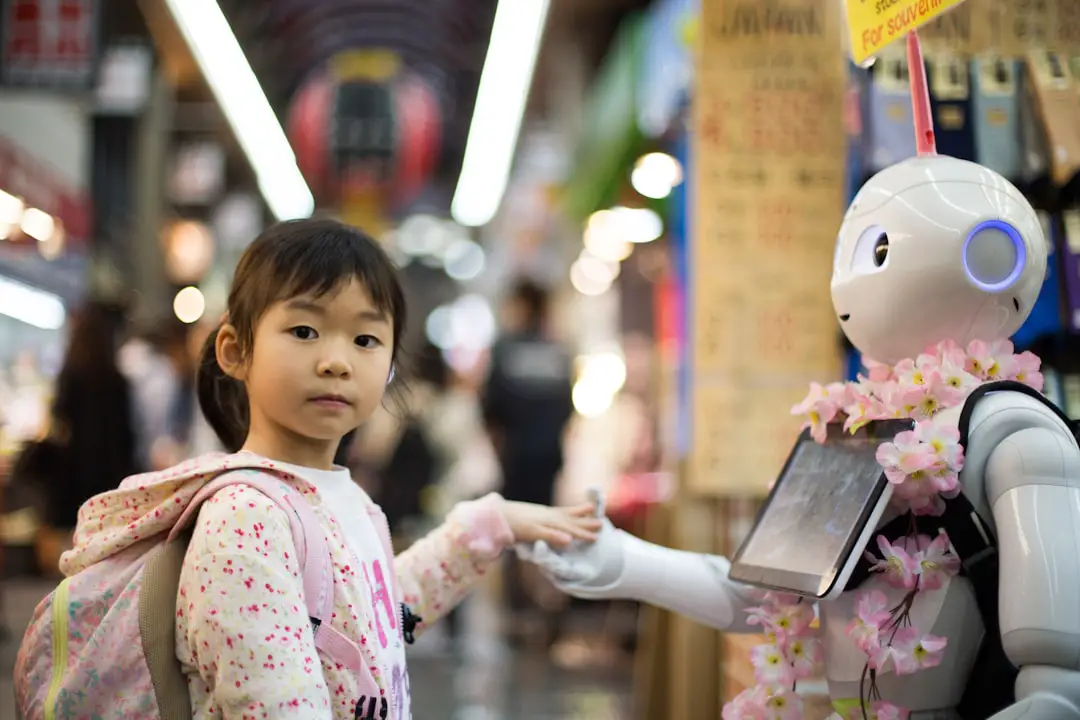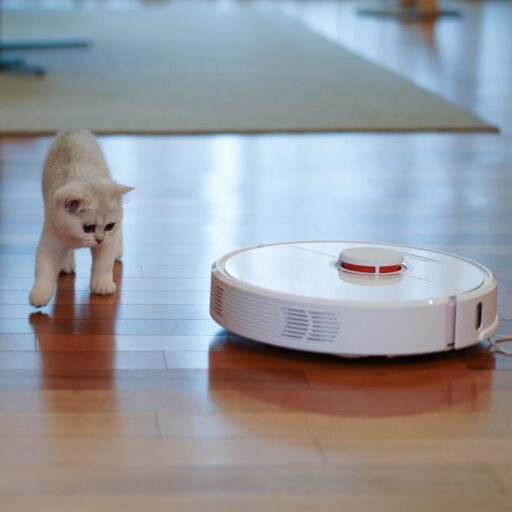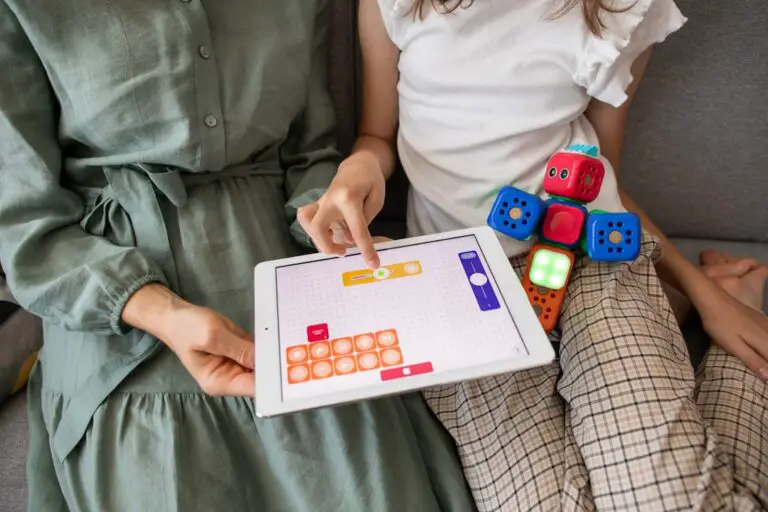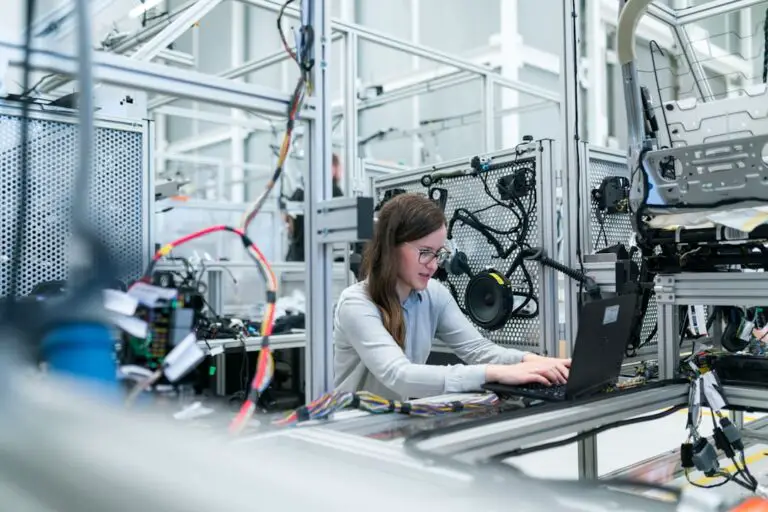Support our educational content for free when you purchase through links on our site. Learn more
How Do We Tell Robots What to Do? 🤖 The 7 Steps to Programming Your Next Robot [2024]
It’s no longer science fiction—robots are everywhere, from factories to homes. But how do we make these machines obey our every command? Think back to your favorite childhood toy—remember the meticulous instructions you had to follow to make it work? It’s the same with robots, but instead of colorful paper manuals, they rely on specific programs filled with commands and actions. In this post, we’ll take a deep dive into the fascinating world of robot instructions and explore the 7 key steps to programming your own robotic masterpiece!
Quick Answer
Robots are programmed using a series of instructions called a program. 🧠 This program is often written in a specialized programming language that the robot can understand. The programming process involves:
- Planning the robot’s route and actions.
- Breaking down the task into smaller steps.
- Translating these steps into programming code.
- Running and testing the program to ensure it works correctly.
Want to get started with your own robot projects? Checkout these robotic kits for beginners:
👉 CHECK PRICE on:
Table of Contents
- Quick Tips and Facts
- The Evolution of Robot Instructions: From Punch Cards to AI
- Understanding Robot Languages: From Simple Commands to Complex Programs
- Programming Robots: A Step-by-Step Guide
- Types of Robot Instructions
- Real-World Applications: Robots at Work
- The Future of Robot Instructions: Where will robots be programmed tomorrow?
- Conclusion
- Recommended Links
- FAQ
- Reference Links
Quick Tips and Facts
Did you know that robots, just like your smartphone, rely on a set of instructions to operate? 🤯 These instructions, called programs, are essentially the robot’s brain, telling it exactly what to do and how to do it. Imagine a robot chef following a recipe, or a robot vacuum cleaner navigating your living room – it’s all down to the instructions!
We’ve all heard of robots doing complex tasks, but did you know these complex actions are broken down into simple steps for the robot to understand? This is similar to how your computer understands a complex program by breaking it down into smaller bits of code. The future of robot instructions is exciting, with AI and machine learning taking center stage! Learn more about how these advancements are shaping the world of robotics in Robotics [https://robotinstructions.com/category/robotics/].
The Evolution of Robot Instructions: From Punch Cards to AI
Robots have come a long way since the early days of punch cards and rudimentary programming languages. Back in the 1950s, robots were controlled by punch cards, resembling the ones used in old-school player pianos. 🎹 Each card contained a specific instruction for the robot, and they were fed into a special reader to control the robot’s movements.
As technology advanced, programming languages became more sophisticated. Robots started using more intuitive languages like BASIC and Pascal allowing for more complex and flexible operations. In the 2000s, graphical programming interfaces emerged, making it easier to understand and create programs visually, using drag-and-drop features.
The rise of AI is revolutionizing the way we think about robot instructions. Artificial Neural Networks (ANNs) can now learn patterns from data and adapt their behavior accordingly. Robots are becoming increasingly autonomous, capable of making decisions and reacting to changes in their environment without explicit human intervention.
👉 CHECK PRICE on: Amazon Search for “Robot Toys”
Understanding Robot Languages: From Simple Commands to Complex Programs
To understand how instructions are given to robots, you need to grasp the concept of robot languages:
-
Low-level Languages: These are the most basic languages, often referred to as “machine code.” They use binary codes (0s and 1s) that the robot can directly understand. Think of it as the alphabet of robot instructions.
-
High-level Languages: These languages are more human-readable and easier to program, like Python or C++. They are like a spoken language, allowing you to give instructions in a more understandable way. The robot translates these instructions into lower-level commands that it can execute.
-
Proprietary Languages: Some robot manufacturers use their own unique languages designed specifically for their robots. This can be useful for specific functionalities and optimizations.
Think of it like this: Imagine instructing a robot to pick up a glass of water. With a low-level language, you’d have to write a series of complex commands about motor movements, joint angles, and grip pressure. But with a high-level language, you can simply say: “Pick up the glass of water, please.”
Programming Robots: A Step-by-Step Guide
You’re ready to make your very own robot program? 🤖 Let’s break down the process step-by-step:
Planning the Route
First, visualize the task. What path does the robot need to take? Imagine a robot trying to navigate a room full of furniture. You need to plan the route carefully, avoiding obstacles and ensuring the robot can reach its destination.
A List of Steps
Now, break down the task into smaller steps. For example, if the robot needs to pick up a ball, the steps might include:
- Moving to the ball’s location.
- Extending its arm.
- Grasping the ball.
- Retracting its arm.
- Moving to the designated drop-off point.
This detailed list of instructions is called an algorithm, which is essentially a step-by-step guide for the robot to follow.
Robot Instructions
Next, translate these steps into robot-understandable instructions. This involves using the appropriate programming language and writing specific commands for each step. You might need to define variables, like the ball’s location and the robot’s arm length, to make the instructions more precise.
Making the Program
You now have all the pieces! Assemble them into a program, which is basically a collection of instructions organized in a specific sequence. Think of it as a recipe for the robot to follow.
Did the Program Work?
Now it’s time for the exciting part! Run the program and observe the robot’s actions. Does it follow the instructions correctly? Does it complete the task as expected?
Looking for Bugs
Sometimes, even the most carefully planned programs can have errors. These errors are called bugs, and they can cause the robot to malfunction.
Debugging is the process of identifying and fixing these bugs. It’s like finding typos in a recipe! You’ll need to carefully analyze the robot’s behavior and identify the steps where something went wrong.
More on Computer Science
The process of creating programs for robots is closely related to computer science, which is the study of how to design and automate complex tasks. Learning basic computer science concepts like variables, loops, and conditionals can greatly improve your ability to create effective robot programs.
Checkout these resources to dive deeper into the world of programming and robotics:
- Robotics Engineering: Learn about the engineering principles behind robotics.
- Robotic Applications in Entertainment: Explore how robots are used in entertainment.
Types of Robot Instructions
Here are some different ways robots are programmed. 🤖
Direct Robot Control
Imagine using a remote control to move a toy car – that’s direct robot control! The user provides real-time instructions, and the robot responds immediately. However, this method is generally suited for simple tasks and requires constant user input.
Pre-programmed Sequences
Think of a washing machine with different settings for different types of clothes. That’s pre-programmed sequences! The robot is pre-programmed with a set of routines for common tasks, allowing the user to choose from these options. This method is efficient and reliable for repetitive actions, but requires modification for new tasks.
Off-line Programming
Imagine creating a detailed blueprint for a building – that’s off-line programming. The user programs the robot using a computer, typically in a simulated environment. This allows for complex programs and testing before actual execution. It’s good for environments with safety hazards or for tasks that require precision.
Artificial Intelligence and Machine Learning
Remember those robot vacuum cleaners that seem to know exactly where to go? 🤩 That’s AI and machine learning at work! The robot learns from data and experiences, adapting to new environments and even making its own decisions without user intervention. This is the future of robot instructions!
Want to see robots in action? Check out some amazing examples in:
Real-World Applications: Robots at Work
Robots are no longer confined to science fiction! 🧬 They are making waves in a variety of industries:
-
Manufacturing: Robots are used for tasks like welding, painting, and assembly lines.
-
Healthcare: Robots assist surgeons in delicate procedures and provide rehabilitation therapy.
-
Agriculture: Robots help with tasks like planting, harvesting, and weeding.
-
Logistics: Robots are employed in warehouses for sorting, packing, and delivering.
-
Service: Robots are used for customer service, hospitality, and security.
Did you know… there are more robots working in the world today than humans! 😲 This is driven by the increasing demand for automation and efficiency in industries worldwide.
Keep an eye open for robots in the future of these exciting fields:
The Future of Robot Instructions: Where will robots be programmed tomorrow?
The future of robot instructions is brimming with exciting new possibilities. Here’s what we can expect:
-
Increased Use of AI: Robots will become smarter and more autonomous, relying on AI to adapt to new environments and tasks.
-
Inter-robot Communication: Robots will be able to communicate and collaborate with each other, sharing information and working together to complete complex tasks.
-
More Intuitive Interfaces: Robot programming will become easier for non-programmers, with intuitive graphical interfaces and natural language processing.
-
Ethical Considerations: As robots become more sophisticated, it will be vital to consider the ethical implications of their use. We’ll need to ensure that robots are programmed with safety and fairness in mind.
We’re only scratching the surface of what’s possible with robots! The way we program and interact with robots will continue to evolve, unlocking new possibilities and shaping the future of our world. 🌎
Conclusion

So, how are instructions given to robots? It turns out it’s a lot more complex than just telling them what to do! Robots need to understand specific instructions written in a language they can “speak”. The process involves planning, breaking down tasks into smaller steps, translating these steps into programming code, and finally testing and refining the program to ensure it works flawlessly. As AI and machine learning become more integrated with robots, we can expect incredible advancements in how we program and interact with them. The future of robotics is exciting, with endless possibilities on the horizon for how robots will impact our lives. 🚀
Recommended Links
👉 CHECK PRICE on:
- iRobot Roomba j7+: Amazon | Walmart
- ABB Robotics: ABB Official Website
👉 Shop Robots on:
Read more:
- “The Robot Will See You Now: The Rise of Robots in Healthcare” by Amazon
- “Robotics, Vision, and Control: Fundamental Algorithms in MATLAB®” by Amazon
FAQ

What provides instructions to the robot?
The robot controller provides the instructions to the robot. Think of it as the robot’s brain, receiving and interpreting commands from the program. This controller is usually a computer that processes the program and sends signals to the robot’s actuators (motors, joints, etc.) to execute the instructions. 🤖
What is the difference between a robot and a robot controller?
A robot is the physical machine, incorporating sensors, actuators, and other components. The robot controller is a separate unit, typically a computer, responsible for understanding and executing the program. It is the “brain” that translates instructions into actions for the robot’s body to carry out.
What are the common methods of teaching a robot?
- Direct Robot Control: This involves manually guiding the robot through its motions, like using a joystick or touch screen. It is suitable for tasks requiring real-time adjustments, but can be tedious for complex movements.
- Pre-programmed Sequences: The robot is programmed with a set of predefined routines for specific tasks. It’s efficient for repetitive actions, but requires modification for new tasks.
- Off-line Programming: The robot is programmed using a computer in a simulated environment, which is useful for testing and safety.
- Artificial Intelligence (AI) and Machine Learning: The robot learns from data and experiences, adapting to new environments and tasks, demonstrating greater autonomy.
What defines instructions that the robot must follow?
The instructions that a robot must follow are defined in a program written in a robot programming language. Programs can be simple, like a list of commands, or complex, involving logic, algorithms, and data processing.
What is the set of instructions a robot follows?
The set of instructions a robot follows is called a program. Programs are written in various robot programming languages, designed to communicate with the robot’s controller and enable specific actions.
What are some robot programming languages?
Here are a few examples of robot programming languages:
- C++: Popular for high-performance applications.
- Python: Used for general-purpose programming and machine learning.
- ROS (Robot Operating System): A software framework for robot development.
- Assembly Language: A low-level language, often used for specific tasks.
Can I teach my robot to do tricks?
Absolutely! Robots can be taught to perform complex tricks using programming. Imagine teaching a robot to walk a tightrope, play chess, or even dance! Some robots are designed for hobbyists and come with intuitive programming interfaces, making it easier to learn how to program them.
Reference Links
- Robot Instructions™ https://robotinstructions.com/
- iRobot Roomba j7+ https://iRobot.com
- ABB Robotics https://new.abb.com/docs/default-source/investor-center-docs/investor-events/2020/ra_fact_sheet.pdf
- “How are instructions given to robots?” https://brainly.in/question/7560844#:~:text=The%20Robot%20controller%20provides%20instructions,can%20function%20in%20controlled%20manner.
- “Introduction to Robotics: Mechanics and Control” https://www.amazon.com/Introduction-Robotics-Mechanics-Control-3rd/dp/0201543613?tag=bestbrands0a9-20




